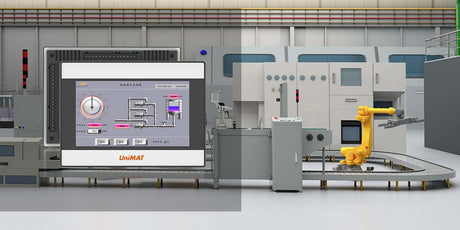In the wave of Industry 4.0,efficient production management and intelligent control systems have become the key to improving the competitiveness of the manufacturing industry.As the two core technologies in the field of industrial automation,human-machine interface(HMI)and supervisory control and data acquisition system(SCADA)play a vital role in realizing the visualization of production processes,improving operational efficiency and optimizing decision-making.

SCADA:The Smart Brain of the Factory
SCADA systems refer to"supervisory control and data acquisition".They are used to monitor and control large areas in real time,such as an entire production plant.In addition,SCADA systems combine many systems,such as sensors,PLCs or RTU sensors.The data collected by all these systems is sent to the central SCADA unit,which will have its own HMI.The purpose of the SCADA system is to diagnose errors,manage production and improve the company's processes.SCADA systems store a lot of information and allow multiple people to operate on the same system at the same time.
Here are some of the features of SCADA systems:
Control the system through HMI software
Monitor the production process in real time and complete factory operations
Collect any type of valuable data
Generate practical real-time operation reports
Automate processes,such as controlling mechanical energy consumption,production peaks,maintenance,etc.
HMI:The bridge between human and machine interaction
HMI,or human-machine interface,is a window for operators to interact with machine equipment.It displays equipment status and production data through a graphical interface,allowing operators to intuitively monitor and control the production process.The HMI system not only simplifies the operation process and reduces the risk of misoperation,but also provides a basis for decision-making for production management through real-time data feedback.
In industrial environments,HMI can be used to:
Display data intuitively;
Track production time,trends,and tags;
Supervise key performance indicators;
Monitor machine inputs and outputs;
Factory floor operators may use HMI to check and control the temperature of industrial water tanks or see if a pump in the facility is currently running.
Basic HMIs include machines,displays,and built-in screens,but regardless of their format or which term is used to refer to them,their purpose is to provide insights into the performance and progress of machinery.

Difference between SCADA and HMI:
HMI and SCADA systems perform similar tasks,monitoring and controlling certain processes,but the main differences between HMI and SCADA are:
HMI is limited to one or two processes/systems,whose monitoring and control are performed locally.
SCADA is usually used to control and monitor more complex systems located in a wider area and requires advanced control tools and techniques.
In short,HMI can be part of SCADA,but SCADA cannot be part of HMI.
SCADA and HMI Development Tools
Human Machine Interface(HMI)is the way humans interact with machines.In industrial environments,HMI is a control panel that can be easily designed,implemented,and modified by simply dragging and dropping graphics in the Sovit2D development platform.Designing HMI using Sovit2D software can save two-thirds of development and modification time.Sovit2D follows the HTML5 standard,is based on B/S architecture,does not require client installation,supports 2D and 3D screen configuration,easily implements 3D visualization and digital twins,supports local/cloud deployment,and can be easily integrated with the user's own system into a comprehensive application platform.It enables users to complete the final automation control project according to their own control objects and control purposes.









